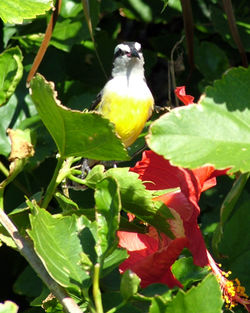Bananaquit
Conservation status Least concern |

|
|
Scientific classification |
| Kingdom: |
Animalia
|
| Phylum: |
Chordata
|
| Class: |
Aves
|
| Order: |
Passeriformes
|
| Family: |
Coerebidae
d'Orbigny &
Lafresnaye, 1838 |
| Genus: |
Coereba
Vieillot, 1809 |
| Species: |
C. flaveola
|
|
|
Binomial name |
Coereba flaveola
(Linnaeus,
1758) |
The Bananaquit, Coereba flaveola, is a
passerine
bird, the only member of the genus Coereba and is
normally placed within the family Coerebidae, although there
is uncertainty whether that placement is correct (hence the
assignment Genus Coereba
Incertae sedis). It is resident in tropical South
America north to southern Mexico and the Caribbean. It is a
rare visitor to Florida, USA.
The Bananaquit is a very small bird attaining an average
length of 11 cm. It has a slender, curved bill, adapted to
taking nectar from flowers. It sometimes pierces flowers
from the side, taking the nectar without pollinating the
plant. It cannot hover like a
hummingbird, and must always perch while feeding. It
will also eat fruit and insects. It often visits gardens and
may become very tame.
Upperparts are dark grey with a black crown to the head
and yellow underparts and rump. The Bananaquit has a
prominent white eyestripe. Sexes are alike.
On
Grenada and Saint Vincent, most Bananaquits have black
plumage, suggesting divergence from other West Indian populations.
Bananaquits build spherical lined nests with a side
entrance hole, laying up to three eggs.
References
- BirdLife International (2004).
Coereba flaveola. 2006
IUCN Red List of Threatened Species.
IUCN 2006. Retrieved on 12 May 2006. Database entry
includes justification for why this species is of least
concern




